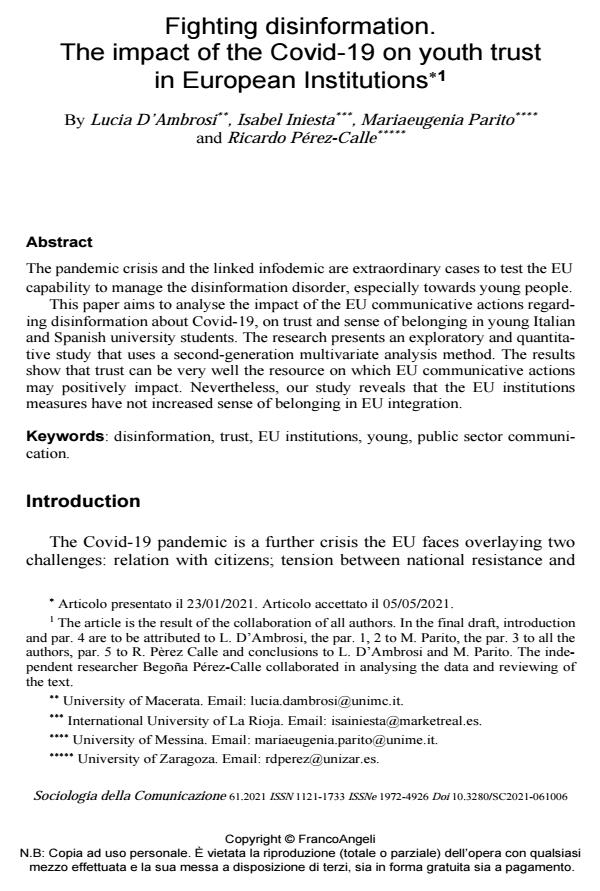Fighting disinformation. The impact of the Covid-19 on youth trust in European Institutions
Journal title SOCIOLOGIA DELLA COMUNICAZIONE
Author/s Lucia D’Ambrosi, Isabel Iniesta, Mariaeugenia Parito, Ricardo Pérez-Calle
Publishing Year 2021 Issue 2021/61
Language English Pages 19 P. 71-89 File size 295 KB
DOI 10.3280/SC2021-061006
DOI is like a bar code for intellectual property: to have more infomation
click here
Below, you can see the article first page
If you want to buy this article in PDF format, you can do it, following the instructions to buy download credits

FrancoAngeli is member of Publishers International Linking Association, Inc (PILA), a not-for-profit association which run the CrossRef service enabling links to and from online scholarly content.
The pandemic crisis and the linked infodemic are extraordinary cases to test the EU capability to manage the disinformation disorder, especially towards young people. This paper aims to analyse the impact of the EU communicative actions regarding disinformation about Covid-19, on trust and sense of belonging in young Italian and Spanish university students. The research presents an exploratory and quantitative study that uses a second-generation multivariate analysis method. The results show that trust can be very well the resource on which EU communicative actions may positively impact. Nevertheless, our study reveals that the EU in-stitutions measures have not increased sense of belonging in EU integration.
Keywords: disinformation, trust, EU institutions, young, public sector communi-cation.
- Infodemic Disorder Alessandro Lovari, Marinella Belluati, pp.65 (ISBN:978-3-031-13697-9)
- Towards a conversational public administration? Giulia Banfi, Marco Luca Pedroni, in RDBCI: Revista Digital de Biblioteconomia e Ciência da Informação /2025 pp.e026005
DOI: 10.20396/rdbci.v24i00.8680284
Lucia D’Ambrosi, Isabel Iniesta, Mariaeugenia Parito, Ricardo Pérez-Calle, Fighting disinformation. The impact of the Covid-19 on youth trust in European Institutions in "SOCIOLOGIA DELLA COMUNICAZIONE " 61/2021, pp 71-89, DOI: 10.3280/SC2021-061006